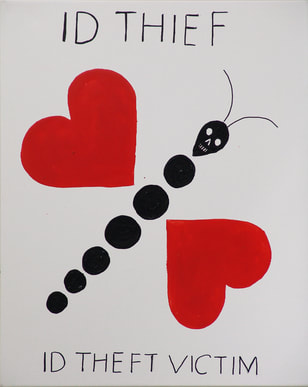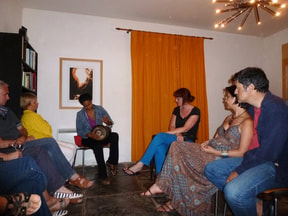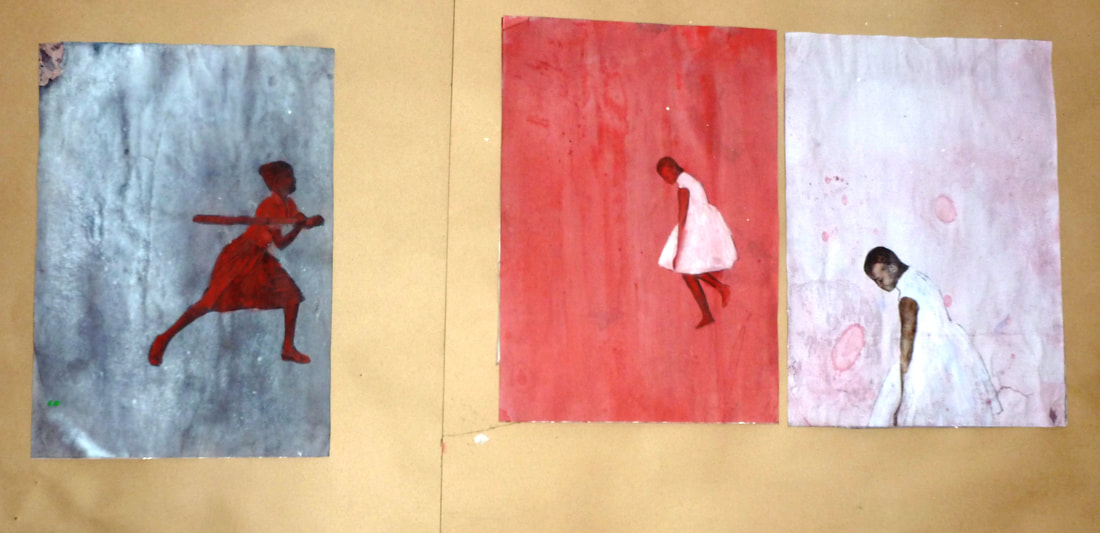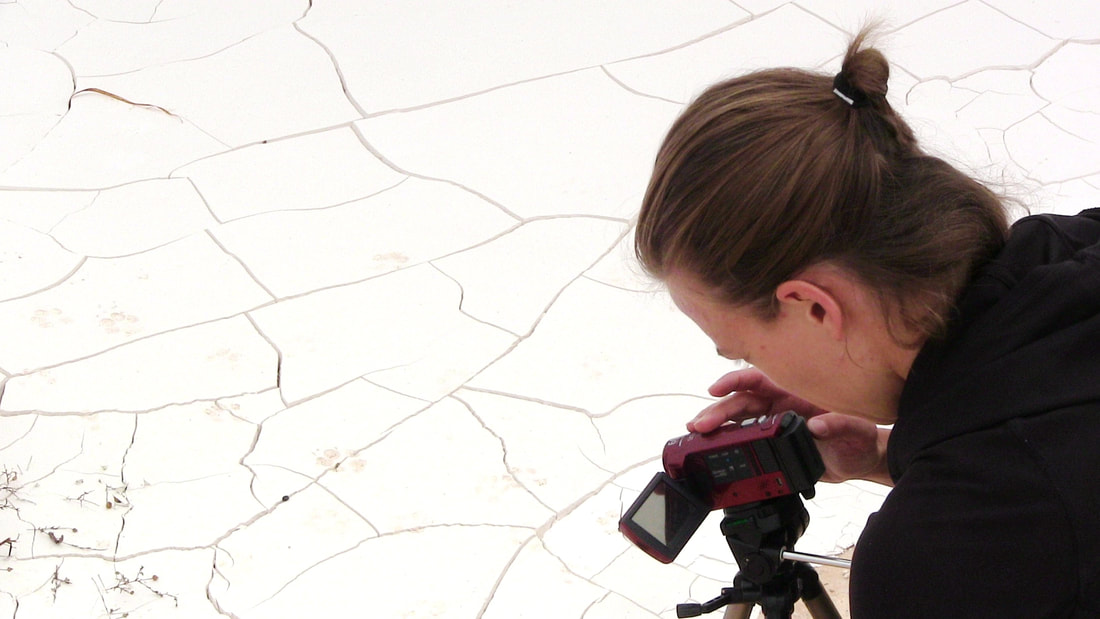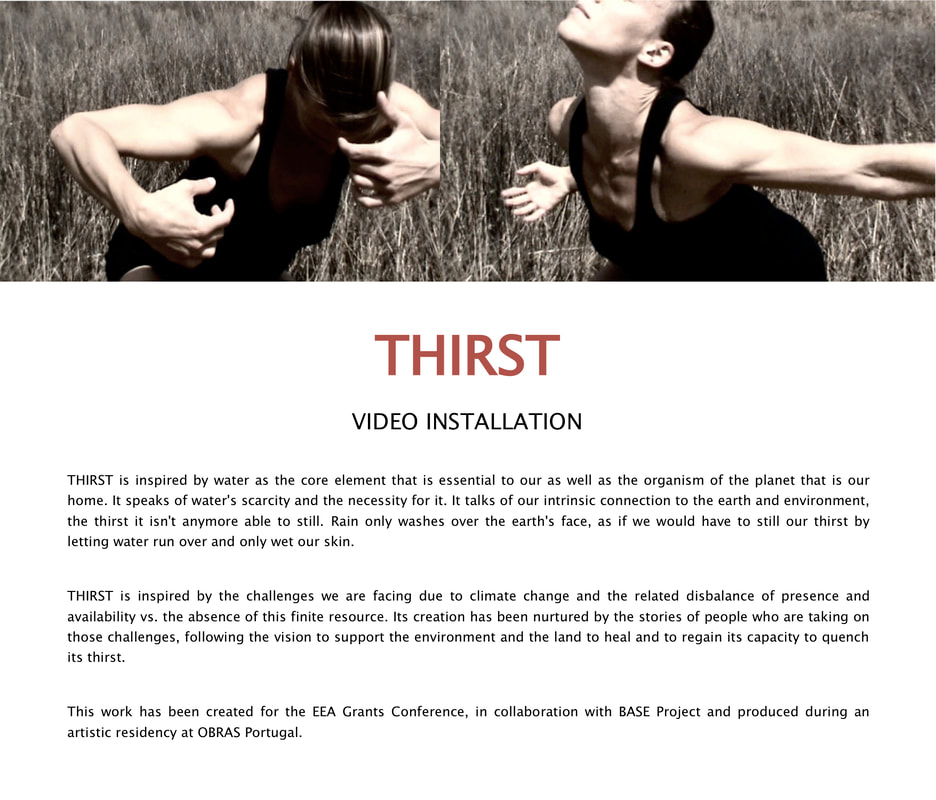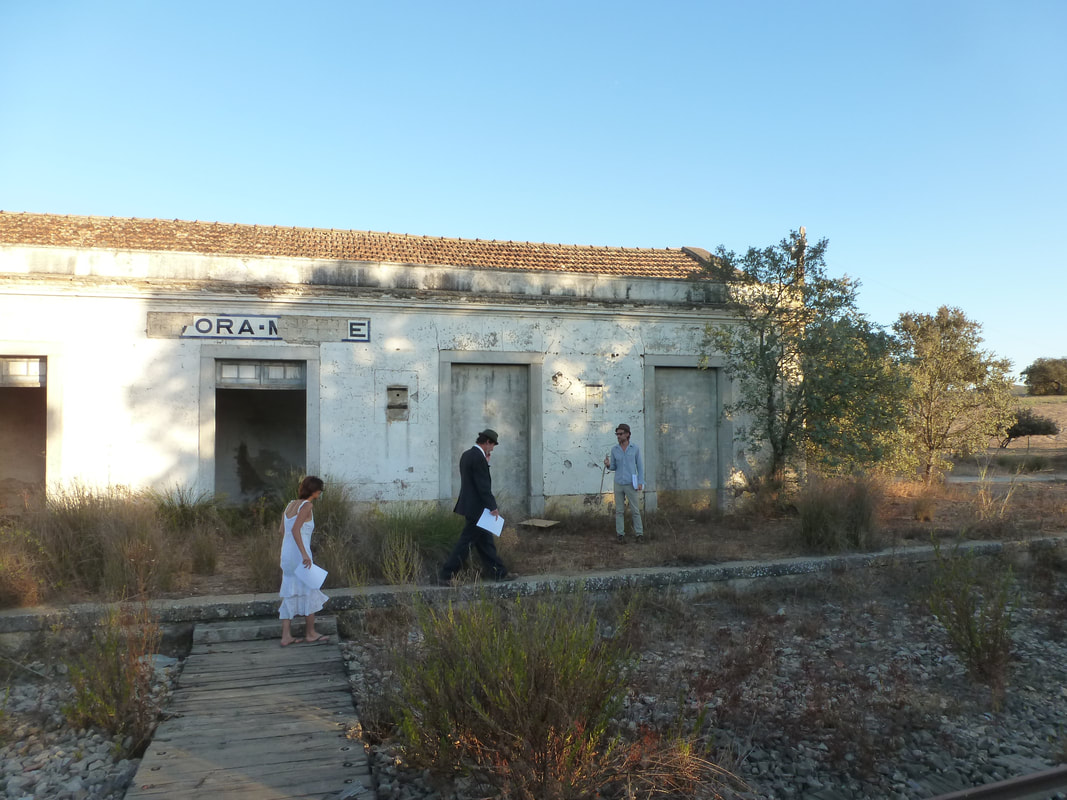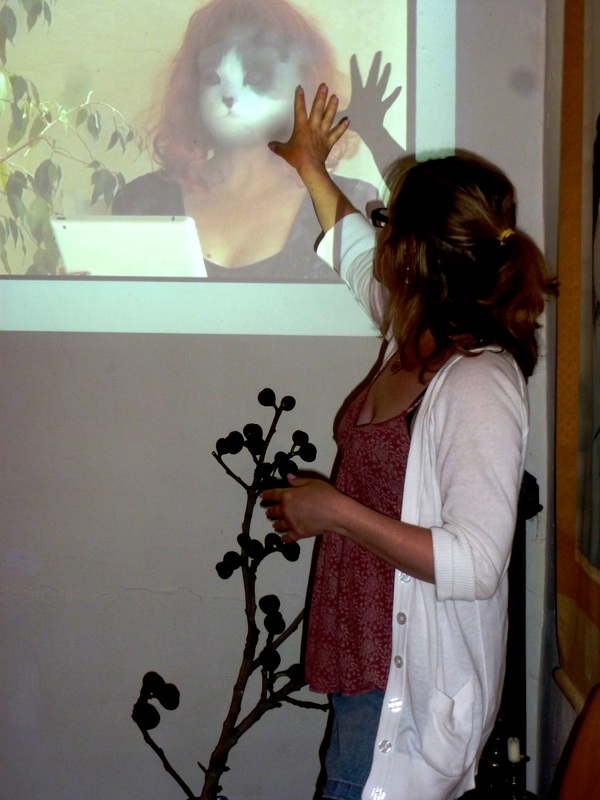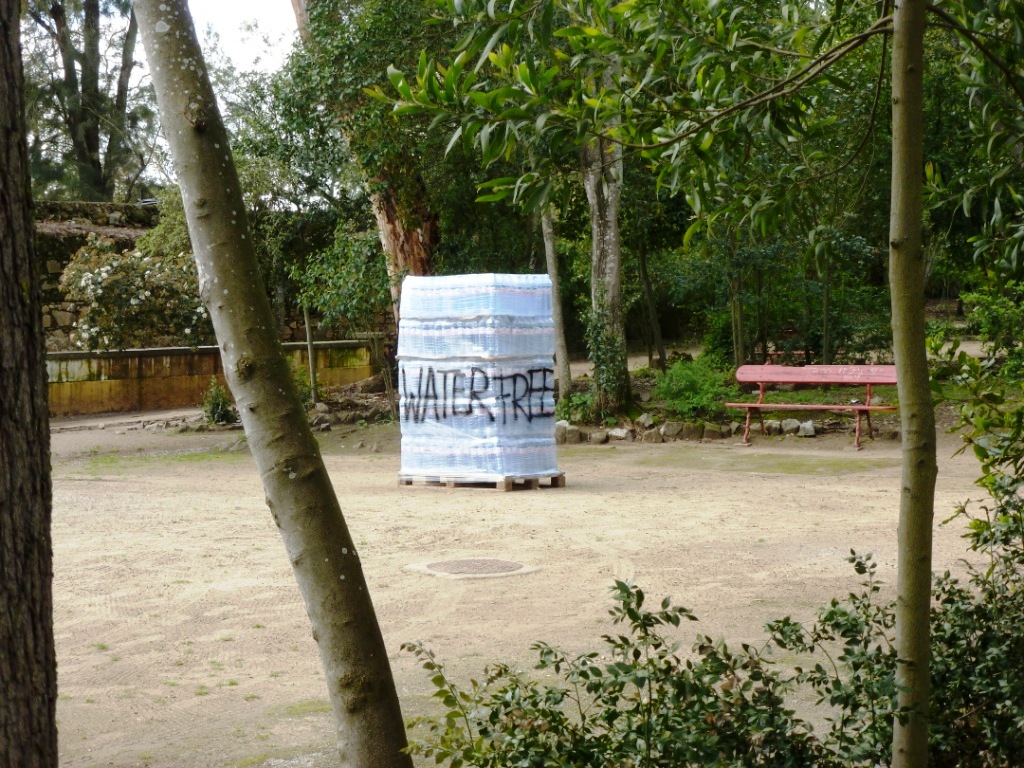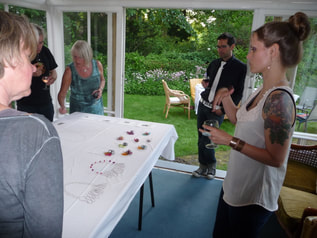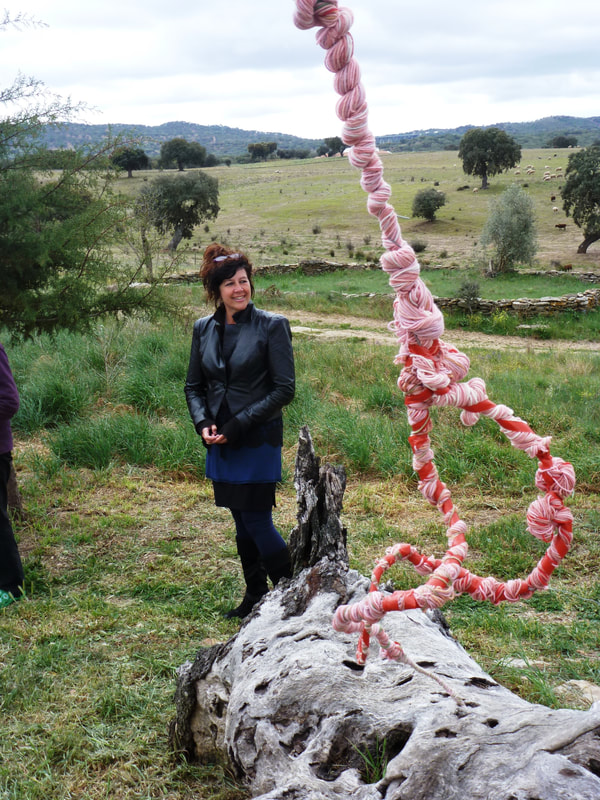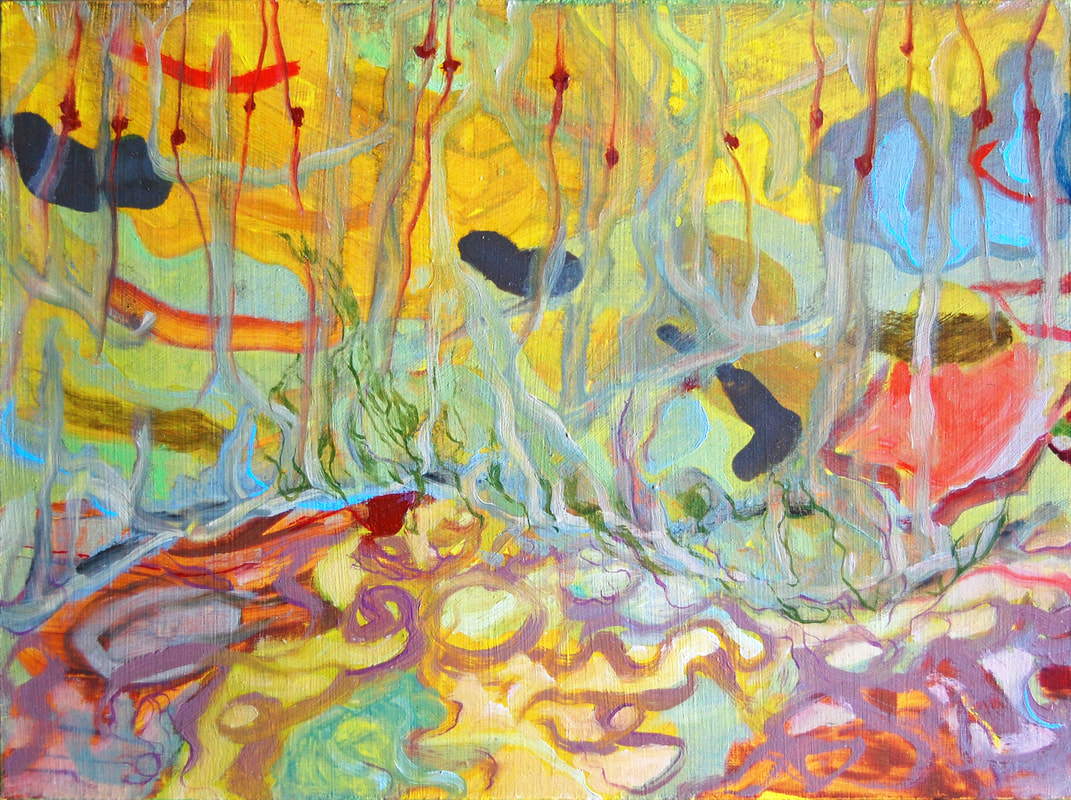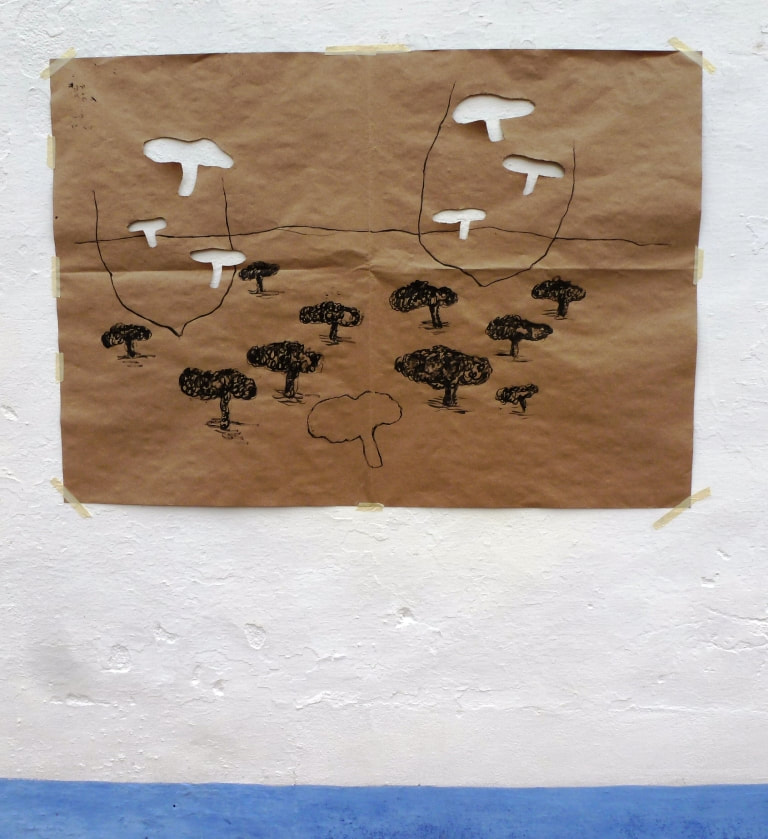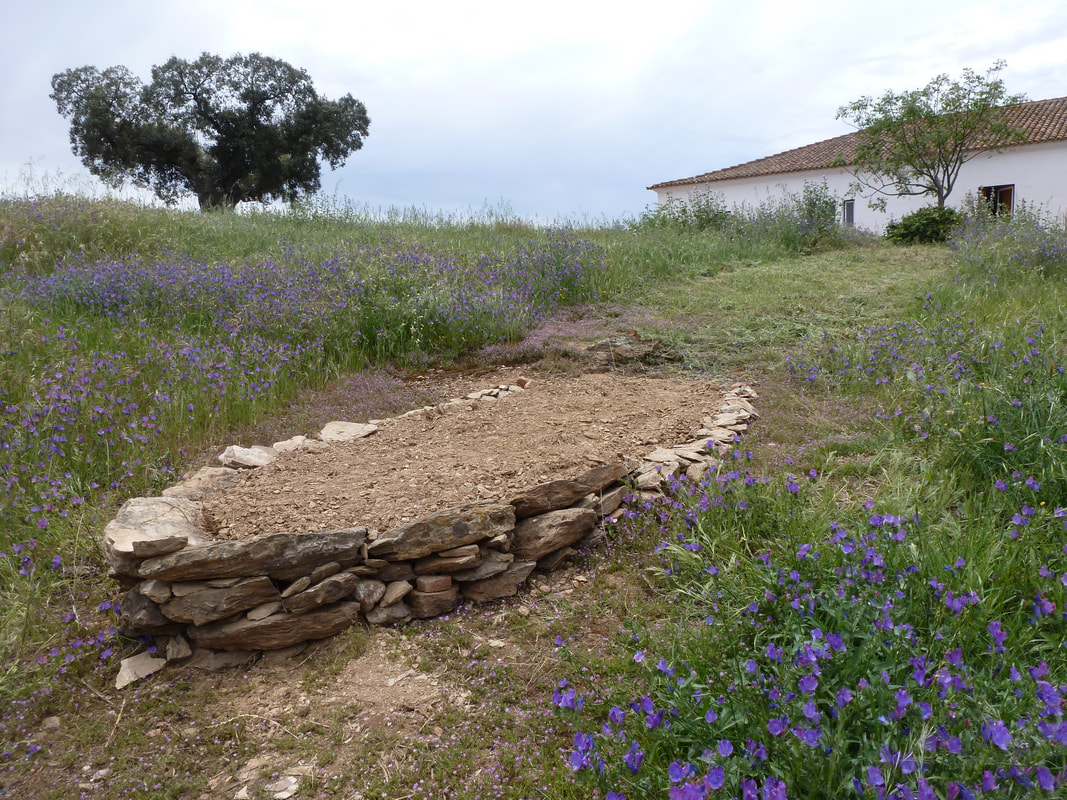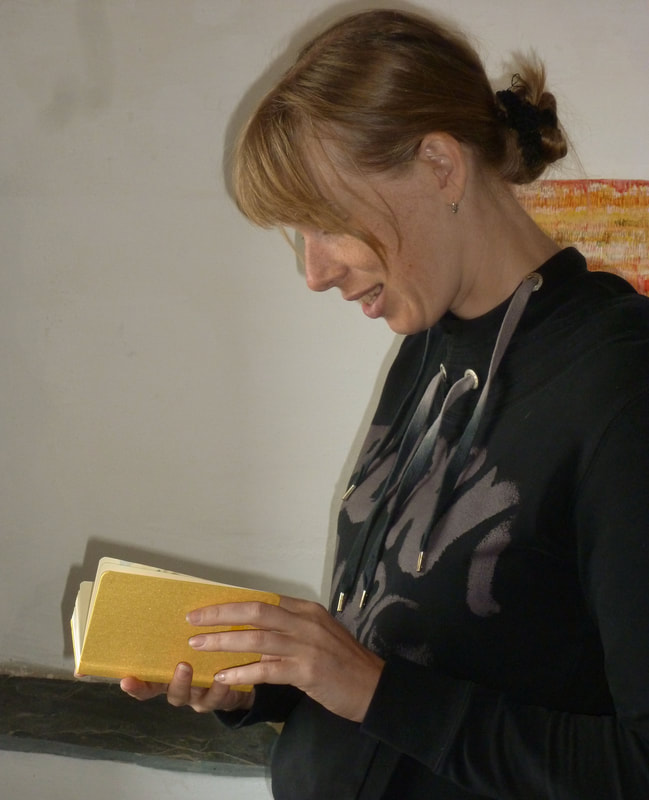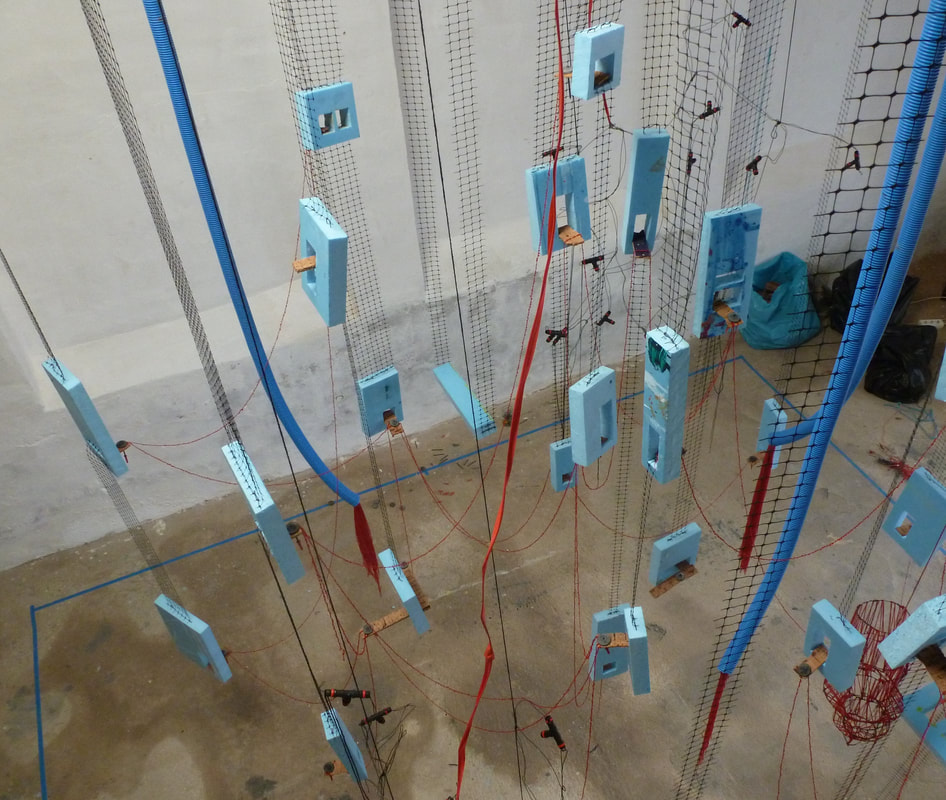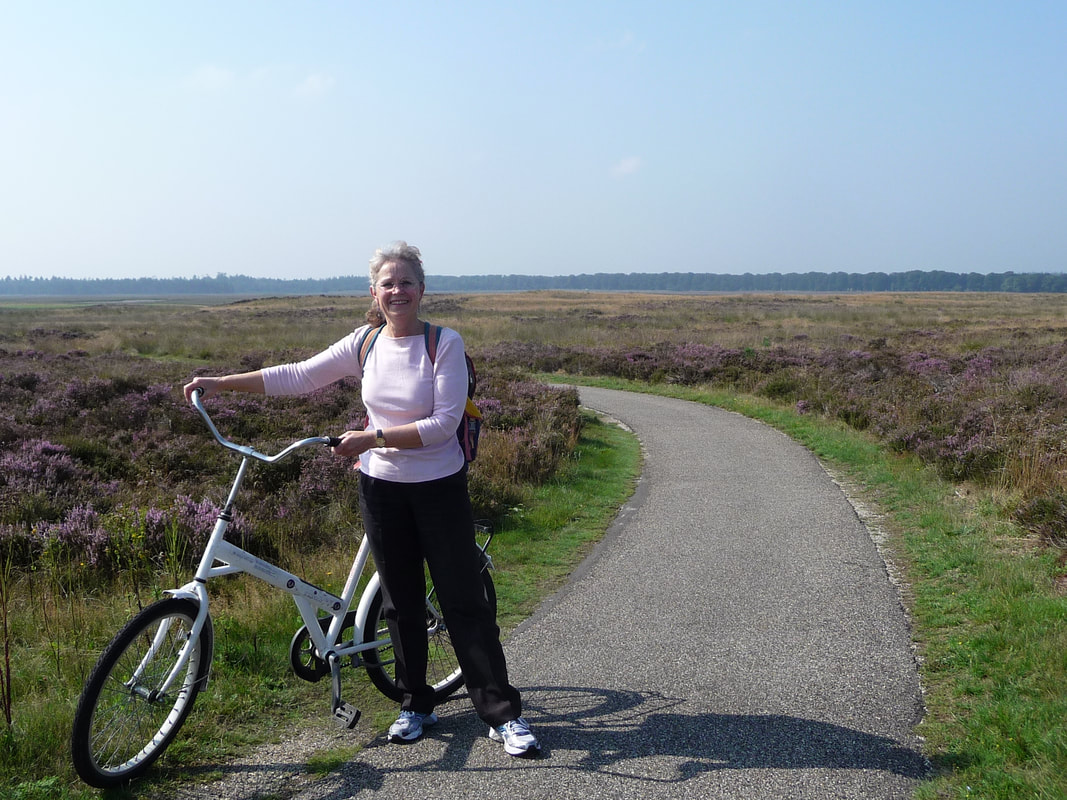Residents and their projects in 2012 and 2013
|
|
James Westwater (USA) made installations with found objects: generally simple in form and intriguing because of its suggestion to contain a meaning or message. He also started “un-authorized conversations” with former residents by overpainting try-out their paintings and then grinding his overlay partly away. We scheduled a grand solo exhibition for him in The Castle of Evoramonte, Portugal in 2015.
Rachel Tzvia Black (poet; Israel) was working on her book with haiku-like poems of lament and elegy. She was also finishing a translation of poems of Tuvia Ruebner (1924), who often takes visual art as a starting point. Rachel impressed everybody while reciting his poems in Yiddish and English. Andrea Hackl (dancer, choreographer; Austria) created an installation: Thirst, for a scientific conference on water and climate change. In the fields around our Center she covered her skin with red mud and recorded herself dancing in a dry landscape. She tried to catch both the physical behavior of the water-soil combination and the perception of people on water shortage. Lauren Camarata (multi media; USA) made photos of residents with their head covered with a tissue. The series contemplates on identity, personality, privacy and modeling. Another project was composing and arranging a multi layered piece for guitar in which the acoustics of the fortress of Evoramonte was used as an additional instrument. Harald Havsteen (mixed media; Denmark) was working on a graphical novel and on a script for a theatre play. Another, ongoing project emerged from an absurd but true happening: his domain name and face book profile picture was stolen and mis-used by an apparently Russian person, probably with an art education, but currently a breeder of hairless cats. Harald is using these facts in combination with personal fantasies for making cartoons, strip stories and poster-like paintings. Boaz Balachsan (animation movie maker; Israel) was working on several movies. He was highly inspired by two invitations, one in Germany and one in South Korea, for featuring his price winning movie: God is Kidding. Cody Healy (moviemaker; USA) made a new motion graphics reel and two video projects. One video is a reflection on the act of traveling. It shows shots of urban and rural landscapes through the window of an airplane, a train or a ferry. Anna Ortiz (painter; USA) was painting urban scenes. They intrigue due to the subject (a waste pile for instance) and visual language (figurative, but with obvious hints to geometric abstraction). Helena Aikin (multi media; Spain) prepared in 2012 and constructed in 2013 a walkable labyrinth in the Jardim Publico in Evora. The form of the labyrinth was inspired by an over 6000 years old petroglyph from the North of Spain that is thought to be solar and moon calendar. Helena Aikin also has a fascination for the universal formal language in prehistoric paintings, especially goddesses. She is drawing and modeling these figures and re-creates them in her own style. Erika Dahlen (painter; Sweden) came twice to prepare her exhibition: Qualia, in April 2014 in the Palaçio de D. Manuél in Évora. Erika experimented with fluorescent paint and cork strips. She points to the idea that we interpret, rather than see reality: we look at a canvas, but experience a painting. Erika is also puzzling with the notion of nothing: silence, emptiness, darkness. For her nothing is not related to nihilism. On the contrary: it represents values such as space, believe and immaterialism. Kit Reisch (kinetic arts; USA) is preparing a solo exhibition in Prague, the town where he lived in 2013. At OBRAS he focused on drawing. Both his kinetic art installations and his drawings are inspired by architecture. But he takes the objects out of their context and gives them an additional meaning. His work is full of craftsmanship, but in the same time highly artistic because of its originality, esthetics and visionary suggestion. At the end of his residency he showed some hundred sketches (some of them were master pieces by themselves). Youngwha Kang (composer, South Korea) made compositions, inspired by sounds and experiences at OBRAS. She deeply impressed her audience when she presented some of her works during her artist talk. Her starting point is generally an ancient poem. Seemingly simple music, played on a Korean sitar and wind instrument, was mixed with sounds of conversations, sheep bells and poetic phrases. The result was harmonious, meditative, romantic and surprising. Everybody in the audience ordered her CD. Iris Burghout (mixed media, Holland) collected seeds, cork, bee wax and paper and included them in her collages. Her compositions are playful and atmospheric. Many of them are abstracted flower motives. As she came on the days of the Perseids she also dedicated a work on shutting stars. Gerry van der Linden (poet) and Wouter Thorn Leeson (photographer, film maker), both from Holland, worked on a project on drinking water. They did shootings on the aqueduct of Lisbon and around fountains in Alentejan villages. Gerry created several new poems and recited some of them at sun set. Sally Stafford (painter, UK) returned for the fifth time. This year she chose the ripening of wild barley as her source of inspiration, partly because she saw similarities with her own hair and partly because is considered it to be a a metaphor for life in general. While in some of the past years her paintings were vibrant, colorful and expressive, her current work is delicate, whitish gold and introvert. Although it is abstract it suggests silence in a sun bleached landscape. Victoria Cattoni (Australian visual artist, living in Singapore) is first of all a video maker. She showed some recent work: general inspired by gender issues in Asian countries. They are moving, funny and impressive in the same time. During her residencies in 2012 and 2013 she restarted her career as a painter. She made sensitive and yet powerful abstracts, both in big oil paintings and in small pencil drawings. OBRAS organized three concerts in Holland for Lina Uinskyte (Lithuania, living in Italy; violine) and Mauro Dilema (Italia, living in Portugal; piano): in Nijmegen (kasteel Heyendael), Hilversum (Het Jagthuis) and Zwolle (Thor). All concerts were sold out and the duo got standing ovations. One work was a national premiere, composed by Rolf Straver, a regular resident at OBRAS in Portugal. A video impression is available at OBRAS. Karan Bajaj (India, living in New York) finished a first draft for his new novel highlighting the power of yoga and meditation. With both humor and vision he included his personal experiences of the past few years, which he considers to be a spiritual journey. He sent the draft to his agent, who was directly exited. As his first novel was an absolute bestseller with 200.000 copies sold, his agent assumes convincing a publisher to be no problem. Ies Schute (mixed media, Holland) was directly intrigued by the deep red color in the surrounding clay and puppies. That is how she generally works. She finds inspiration on the spot and let the circumstances determine what she makes. The local flee market, the drives of people around her, the memories from home. Everything contributes to building up mosaics and collages of images. Source of inspiration for Minami Hirosawa (painter, Japan) are her dreams. She dreams a lot, generally bad dreams. But she partly compensates this by making “sweet” drawings, composed out of the best moments in her dream world. And for the first time in her artistic career Minami had the opportunity to work big, up to 8 meters width. This gives her dream world a completely new dimension. The last week of her residency she made an exhibition of all her works. The title of her exhibition was as intriguing and surrealistic as lots of her work: “Portugal, T-shirt and me”. Elaine Pawlowicz (USA) made lots small paintings that look like tiles or icons with a surrealistic image. Her paintings are about the human spirit in a turbulent cosmos. Or more precisely: the place where personal perceptions on home, family and spirituality clash with natural disasters such as earth quacks and tsunamis. Elaine worked incredibly hard as these painting were scheduled to be exhibited two weeks later Istanbul. Melissa Clark (USA) was working on her fourth novel, in this case on young adults. On her deathbed an old woman confesses that she was Mother Nature for the past half century and that her 15-years-old granddaughter will inherit this job. While the girl is fully occupied with her hormones and her poor grades on school, she now must try to balance the precarious state of the world. Would her confusion explain the current state of the universe? Global warming? Animal extinction? Julia Matheson (Australia) is a multi-talent, combining painting, writing and being a lawyer. At OBRAS Holland she focuses on completing two novels: one is called The Stacking. It tells about how little things in our lives may not be felt or fully understood in the moment, but “stack” up – having consequence by virtue of their cumulative weight in one’s history… The second manuscript is called Gabo’s Script and is about a girl who lives through her books. She goes on a quest looking for the author of her favorite book, to ask him to write the script for her life. She believes he would write a better script for her life than she would be able to live without his help. Since 2009 Ingrid Simons (Holland) comes back every year. She is deeply inspired by Portugal: the landscape, the history, the people, the climate, the skies, everything. From the moment she took residencies in Portugal she changed her colors, subjects, formats and media. This was clearly visible at her solo exhibitions in 2010 en 2011 in Évora and 2013 in the Castle of Evoramonte, where she showed 34 works, spaciously divided over two floors. Most were oil paintings, but also ceramic tiles and silk screens. She used the inauguration also to present a book that she produced together with Mark van den Eijnden of STORM. It shows in images and texts about Ingrids´ fascination for Portugal. Also on the inauguration the Évora based saxophone quartet 4SAXEU gave a fantastic small concert. Have a look for an impression of exhibition and music. She is also experimenting with azulejos (blue white tiles) as a surface for abstract images and with ceramic vases, partly under the guidance of Xico Tarefa, master potter of Redondo. Vera Hofmann and Sabine Schründer (Germany) established “Benten Clay”: an artistic corporation in which they explore societal threats and fears. They use photography, video, installation and performance to present work that has elements of documentation, poetry and provocation. During their residency in 2012 they were working on videos on environmental issues in Finland and Iceland. In addition they treated the water issue in Portugal: both the heavy drought period, the pollution caused by empty bottles of mineral water and the policy to privatize public water (see higher on this page for information on their Free Water project in the Jardim Publico in Évora). In 2013 Benten Clay intended to build a 2,5 meters high aqueduct of plastic water bottles and cement in the Jardim Publico in Évora. But technical and esthetic issues forced them to go for a modest project this year: “Free Water”. It refers to public availability of water. A pallet of mineral water bottles was placed in the garden and visitors are free to take bottles away, thereby changing the form of the pile. The simplicity and clearness of the concept impressed many. Erdmute Blach (visual artist, Germany) returned after her residency in 2011 when she started a collaboration with Almilcar Vacques Dias, a Portuguese composer. In 2012 they had performances is Rostock and Hamburg and in 2013 they experimented with a combined music / visual arts performance inspired by Cantas Alentejas. Erdmute also worked for several days together with the Portuguese painter António Tavarez. But also by her own she was amazingly productive. Her quiet spacious studio was too small for all the pieces she is working on. In 2013 and 2014 she worked on an exhibition scheduled in the Palacio de Dom Manuel in in Évora in 2015. More information is on her temporary page. A highlight in 2013 was the exhibition “Deambular…” with Annemie Bogaerts (Belgium, living in Holland). Deambular is freely translated as “walking without a goal”. Annemie made a floor mosaic with marble dust of 11 x 11 meters in the fortress of Evoramonte. It became a walkable labyrinth. Nearly two weeks she was working in this installation, together with her partner Peter de Koning. With no exception the visitors were exited. On the inauguration Luís Pucarinho did sing four ballads: so sensitive and meditative that it turned seventy people into deep silence. John Brazenall (Scotland) is sculptor and bronze caster by origin. He is in a phase of looking for options to give his artistic career a new boost. With very weathered timber wood that he found in an abandoned shed he constructed a table. The piece looked fragile but is surprisingly stable. On the table sheet he rubbed a square of gold leaf. Julia Malle is an Austrian glassblower, living in Scotland. At OBRAS she worked in other disciplines and with other materials, even although her experience with transparency and light was obvious. Julia created together with John Brazenall an installation in an abandoned shed. Eight pillars were surrounded with a floating transparent cube. The space seemed to be filled with emptiness. She also painted a free standing pole turquoise and put a gold leaf square on it, giving the landscape a gentle, surreal mark. And she gave giant marble blocks a personal touch by painting boreholes red. Egle Genes Grunsfeld, a mixed media artist from Israel, made huge spider webs of textile. For her, the spider is a metaphor for a force that unites everyone and everything. At OBRAS Holland Laura Waddington was working on a graphic novel on Iraqi refugees. At her artist talk she showed parts of this work. Her audience was deeply impressed. Thomas Haflik (Austria) has sound poetry and “vertonte lyric” as his specialty: a kind of abstraction of both texts and music. In addition his was working on his debut as novelist: about artists faking a violent action: releasing sounds from houses around a square, which passengers misinterpret as a terrorist attack. António Tavares (painter; Portugal) took a residency because his own studio in Borba is too small for the 2,5x1,5m painting that he decided to make. Merel Holleboom (installations; Holland) experimented with a conic form. She also worked, together with Annemie Boogaerts, on two installations: one in the field (with hay, poles and roof tiles a rosette of 10 m diameter was made) and another in the corridor that connects the apartments (With marble sand and red clay they suggested a road with cross overs). For Annemie Boogaerts her residency was a warming up for her exhibition in the Castle of Évoramonte in 2013. In addition to the installations that she developed together with Merel Holleboom she made lots of smaller “table” sculptures and drawings. An impression is included in the video that also shows work of the other residents of August-September 2012. Mary Lapsey (painter; Australia) was resident in Holland. She works in the tradition of realistic portraits. But there is more: generally the figure shows just his back, making the spectator a voyeur. And in most cases a “still” of an action is shown, questioning the speedy video-world. Also in OBRAS-Holland Tamara Rafkin (USA, working Belgium) worked on several series. She was inspired by a broad range of subjects, from lichen structures to industrial architecture. Her series “Sleeping Houses” was nominated for an award at the UNSEEN Photo Fair Amsterdam. In 2012 Karin Gerfen (visual artist, Holland) made an installation inspired by a story of Italo Calvino on a hanging city. It was a try out for a bigger one (10x10x4m) that was used by dancers in Holland in 2013. During thier performance the audience was sitting on swings while the dancers floated on robes. Eric Layer (novelist, playwright; USA) worked on a story about a writer who scrolls through New York. The story is also an investigation on individuality as related to freedom and loneliness. In addition he wrote a short theatre act for which he invited two actors from Lisbon: John Frey and Sofia Torre. They used the abandoned train station of Evoramonte as a stage. Liam Garstang (visual artist; Australia) worked on several ongoing, very personal projects. One was a big exhibition in Australia: “to kill saudade” , which was shown in Sidney in 2014. The show was about longing, memories, as well as about passing boundaries and closing chapters in life. He showed a video installation in Casa da Zorra, in Évora, entitled: there will be no shepherds anymore. Mikella Gabrielides (yoga teacher; Australia) was studying a text from the famous Indian epic Mahabharata in which yoga is mentioned as a tool for meditation. The content is both narrative and philosophical. For a better understanding Mikella taught herself Sanskrit. Helena Mooren (painter; France) made a large number of abstract paintings in which “light” is the subject. Her specialty is to suggest that light is coming out of the painting towards the spectator. Mihaela Vosganian (composer; Romania) and Natalia Perlaza (percussionist; Colombia, USA) were participating in a IAC workshop. But they made time to mix with the other artists in residence and participate in art initiatives. Mihaela showed an avant-garde opera that she recently created and hopes to perform once in the marble quarry in Vila Viçosa. Natalia granted us an informal percussion concert of amazingly high quality. In June 2012 we hosted and facilitated the rehearsals of a contemporary version of the Divina Commedia. We co-produced the performance in July in an abandoned marble quarry in Vila Viçosa. Click on this clip for an impression. Prinicpal producer was Escrita na Paisagem. Miira Sippola was project leader, director and script writer. The whole crew resided for five weeks at OBRAS. Actors were from Finland (Idalotta Backman, Ulla Raitio, Jaakko Kiljunen, Tuomas Tulikorpi), Portugal (Fábio Moreira, André Salvador, Susana Nunes, Diana Niepce, Sofia Ramos, Tania Chita, Vicente de Sá, Jõao Bandeira), Greece (Nantia Papatheodorou) and Japan (Yuko Takeda). They were supported by Aili Ojalo (Scenographer, Finland) and by the Portuguese designers: Anaísa Guerreiro (light), Rui Lima, Sérgio Martins (sound) and Sara Machado da Graca (costumes). All four shows were fully booked, standing ovation of the audience, the directors‘ best performance and more than happy actors. That was the final result of the Divina Commedia project. It was the victory after a five-weeks day-and-night battle. The Divina Commedia of Dante (14th century) is an epic poem about a man who follows a winding road from hell to heaven. But basically it is about an exploration of the mind and a search for harmony. Miira wrote a script in which this poem was her starting point. She converted this into an abstracted autobiography with a family drama as overlay. A fantastic concept. Already seven times we hosted and facilitated a theatre project, but this one was by far the most intense. To convert this script into a performance, in close contact with twenty actors and designers, was in itself a winding road from hell to heaven. Five weeks long Marmeleira was a microcosm in which inspiration and frustration, spiritual moments and exploding divas, euphoria and wounded egos, despair and love affairs were all part of daily life. Five weeks proved to be too short and the budget was too small, but all deficiencies were generously compensated by one grand actor: the quarry itself. Fantastic sound and light design, singing and acting did the rest, resulting in this standing ovation. Sandra Trujillo (USA) got a prestigious exhibition in the Palaçio de D. Manuel. She showed narrative drawings, mostly on societal issues, sometimes on personal experiences. The longest drawing was 27 meters. Curtis Stewardson (ceramist, USA) designed table ware in collaboration with Sandra Trujillo. In OBRAS Holland Azila Reisenberger (South Africa) finished an academic paper, titled: Reader’s intention as a determinant in the act of reading” and started with a novel: “Are you in or are you out?”. In between she wrote poetry. Two have been published in a literary journal: “Weeds” (about education, but inspired by weeding the OBRAS-Holland garden) and “Marking the passage of time”. A collective of six artists, named The Family, worked on the theme Homeland. They concluded that homeland is a personal feeling rather than a geographical location. Some rationalized this feeling while others treated it as an illusion. Some wanted to share this feeling while others kept it for themselves. They presented their work in a concert and an exhibition in Casa da Zorra, in Évora. Yvonne Halfens, José Grasso, Peter Bremer, Vincent van Delft (visual artists, Holland), Sibylla Weisweiler (painter, Germany) and Nico Huijbregts (composer, poet and painter, Holland) participated in this event. Miranda Train (novelist; New York) worked on a novel with lots of autobiographical elements: a woman who escapes New York and discovers that traveling is an introspective activity rather than a change of locations. The woman is looking for empowerment needed to live a life in New York and discovers that independency is more effective that controlling relations. Krystel Marois (Canada) made an intriguing and highly artistic series of photos in which "introvertness" seems to be the theme. Many are self-portraits suggesting contemplation, shyness, dreaming or just silent observation of tiny details in the surroundings. In OBRAS Holland Ryan Froggatt (multi media, Canada) worked on a movie about a bicycle travel of a homesick boy. Patricia Kolesar (textile artist and jewelry maker, Canada) made wearable sculptures of thin iron wire and found objects, which refer to love, pain and heartache. Pat Loucks, a Canadian textile artist had her fourth residency at OBRAS in six years. This time she experimented with local and self produced dyes on silk. See this video for an impression of similar earlier work. She got the honorable invitation for a solo-exhibition in Galeria Temporaria in Portalegre: Skin Deep, (2013), that was later also shown Canada. Annemiek Kooijman, a Dutch designer and textile artist, studied on natural surfaces as a source of inspiration for tissue prints. She also made an installation: she extended the branch of a dead oak tree with a string of wool making a loop to the tree stem. It refers to heavenly as well as earthy aspects of life. A Swiss family of marble sculptors: Igor, Eddy and Margret Reinhart came back in 2012 to work in Estremoz marble. It was the third time. Mariana Sipos (Romania) was working on a novel, partly biographic, partly fiction on Paulo Goma, a dissident writer during the Ceausescu regime. Margriet Smulders (Holland) got a prestigious and challenging assignment: to make a mural painting of 4x20m on the outside wall of the museum van Bommel van Dam in Venlo, Holland. She used an outside wall of our big hall as play ground for her try outs. Lys Vosselmans, a very gifted portrait painter, acted as the assistant of Margriet Smulders, both at the try outs and with the final version. Besides that, Lys worked on her own projects: some intriguing still-lives and a portrait. Rachael Post (USA) worked on a book, entitled Dragon girl. It basically is a teenager novel: a personal journey from poverty to a ruling dragon master. In addition to a written version she is working, together with an artist from Taiwan, on an online graphic version of the novel. Carolina Trigo (Slovenia, living in Argentina, Finland and USA) worked on a performance. For this she prepared a burqa type of costume in which slogans and religious texts are embroidered. The audience will be invited to cut text parts out of the costume and to rearrange them into a new text. Margaret Leonard (USA) generally paints colorful street lives with societal content. In OBRAS Holland she created a new series, inspired by her direct surroundings and by nature. |
|

